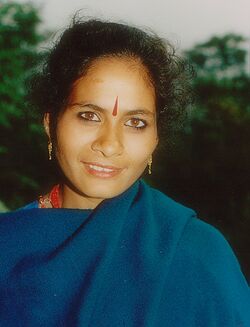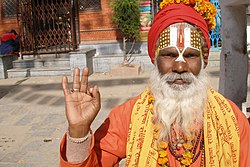Religion:Tilaka
In Hinduism, the tilaka (Sanskrit: तिलक), colloquially known as a tika, is a mark worn usually on the forehead, at the point of the ajna chakra (third eye or spiritual eye) and sometimes other parts of the body such as the neck, hand, chest, or the arm.[1] The tilaka may be worn daily for decorative purposes, as a symbol for sectarian affiliation, for rites of passage or for special spiritual and religious occasions, depending on regional customs.[2][3] It is also used as an expression of honour or to welcome someone upon arrival.[4]
Tilakas come in an assortment of styles or shapes and are adorned using various material such as "ash from sacrificial fire or cow dung, sandalwood paste, turmeric, clay, charcoal or red lead."[5][6][7]
Variations and meaning
Different Hindu denominations use different materials and shapes to make the tilaka.[6]
Traditionally, a staunch Vaishnavite would mark twelve parts of the body with tilakas and other symbols, but the most prominent tilaka is displayed on the forehead. The Vaishnava tilaka, also known as urdhva pundra, consists of a two or three vertical lines starting from just below the hairline to almost the end of one's nose tip, and intercepted in the middle by an elongated U. The style of the urdhva pundra varies in each Vaishnavite sect throughout India and can be made with sandalwood paste or various other materials.[3][7]
According to Dr. Vijay Prakash Sharma, the known styles include:[8] Vijayshree – white tilaka urdhva pundra with a white line in the middle,[8] founded by Swami Balanand of Jaipur; Bendi tilaka – white tilaka urdhva pundra with a white round mark in the middle,[9] founded by Swami Ramprasad Acharya of Badasthan Ayodhya; and Chaturbhuji tilaka – white tilaka urdhva pundra with the upper portion turned 90 degrees in the opposite direction, no shri in the middle, founded by Narayandas of Bihar, ascetics of Svarg Dvar of Ayodhya follow it.
Additional styles include: Vallabha Sampradaya Tilaka, Sri Tilaka of Rewasa Gaddi, Ramacharandas Tilaka, Srijiwarama tilaka, Sri Janakraja Kishori Sharan Rasik Aliji tilaka, Sri Rupkalajee tilaka, Rupsarasji tilaka, Ramasakheeji tilaka, Kamanendu Mani tilaka, Karunasindhuji tilaka, Swaminarayana Tilaka, Nimbarka tilaka, and Madhva tilaka.[10]
The Vasudeva Upanishad, a Vaishnava tradition text, explains the significance of three vertical lines in urdhva pundra tilaka to be a reminder of Brahma, Vishnu, Shiva; the Vedic scriptures – Rigveda, Yajurveda and Samaveda; three worlds Bhu, Bhuva, Svar; the three syllables of Om – a, u, m; three states of consciousness – awake, dream sleep, deep sleep; three realities – Maya, Brahman and Atman; the three bodies – sthula, sukshma, and karana.[11][12]
Shaivite tilakas
The Tripundra or Rudra-tilaka is the other major tilaka variant, often worn by the followers of Shiva.[13][14] It consists of three horizontal bands across the forehead with a single vertical band or circle in the middle. This is traditionally done with sacred ash from sacrificial fires, also known as vibhuti. The use of vibhuti is symbolic of detachment to the world or renunciation.[15] This variant is the more ancient of the two and shares many common aspects with similar markings worn across the world.[3]
Chapter 2 of the Kalagni Rudra Upanishad, a Shaiva traditional text, explains the three lines of a Tilaka as a reminder of various triads: three sacred fires, three syllables in Om, three gunas, three worlds, three types of atman (self), three powers in oneself, first three Vedas, three times of extraction of the Vedic drink Soma.[16][17]
- The first line is equated to Garhapatya (the sacred fire in a household kitchen), the A syllable of Om, the Rajas guna, the earth, the external self, Kriyā – the power of action, the Rigveda, the morning extraction of Soma, and Maheshvara.[16][17]
- The second streak of ash is a reminder of Dakshinagni (the holy fire lighted in the South for ancestors), the sound U of Om, Sattva guna, the atmosphere, the inner self, Iccha – the power of will, the Yajurveda, midday Soma extraction, and Sadashiva.[16][17]
- The third streak is the Ahavaniya (the fire used for Homa), the M syllable in Om, the Tamas guna, Svarga – heaven, the Paramatman – the highest self (the ultimate reality of Brahman), Jnana – the power of knowledge, the Samaveda, Soma extraction at dusk, and Shiva.[16][17]
These lines, represent Shiva's threefold power of will (icchāśakti), knowledge (jñānaśakti), and action (kriyāśakti).[18] The Tripuṇḍra described in this and other Shaiva texts also symbolises Shiva's trident (trishula) and the divine triad of Brahma, Vishnu, and Shiva.[18]
Other Hindu denominations
Shaktas, worshippers of the various forms of the Goddess (Devi), wear a red dot on the forehead in the middle of three horizontal lines or a semicircular line.[1][19]
Followers of Ganapatya use red sandal paste (rakta candana).[20]
Other traditions
Jains wear the tilaka to mark the forehead of Jaina images with sandalwood paste, during puja ceremonies.[21] It may also be used, for the same reason, to mark idols at the start of a puja (worship), to mark a rock or tree before it is cut or removed from its original place for artisan work, or to mark a new piece of property.[4][22]
Relationship to bindi
Although bindi is related to tilaka there are a few notable differences. Bindi is a dot worn mainly by married Hindu women on the forehead and generally red in color, symbolizing good fortune. Today, it can be found in an assortment of colors, shapes, materials and mainly worn for decorative purposes.[23][24]
See also
- Ash Wednesday – a forehead marking tradition in Christianity
- Bindi – a cosmetic item of decoration for women in South Asia
- Fascinator – a cosmetic item worn near the forehead, an alternative to a hat
- Third eye
- Urdhva Pundra
- Vibhuti – Sacred ash made of burnt wood, burnt cow dung, or from the cremation of bodies.
References
- ↑ 1.0 1.1 Mittal, Sushil; Thursby, Gene (2006-04-18) (in en). Religions of South Asia: An Introduction. Routledge. pp. 73. ISBN 978-1-134-59322-4. https://books.google.com/books?id=n7KCAgAAQBAJ&dq=tilaka+hindu+marks&pg=PA73.
- ↑ Kanti Ghosh, Sumit (2023-05-18). "Body, Dress, and Symbolic Capital: Multifaceted Presentation of PUGREE in Colonial Governance of British India" (in en). Textile: 1–32. doi:10.1080/14759756.2023.2208502. ISSN 1475-9756. https://www.tandfonline.com/doi/full/10.1080/14759756.2023.2208502.
- ↑ 3.0 3.1 3.2 Lochtefeld, James G. (2002) (in en). The Illustrated Encyclopedia of Hinduism: N-Z. Rosen. pp. 709. ISBN 978-0-8239-3180-4. https://books.google.com/books?id=GnmPzgEACAAJ.
- ↑ 4.0 4.1 Axel Michaels (2015), Homo Ritualis: Hindu Ritual and Its Significance for Ritual Theory, Oxford University Press, ISBN:978-0190262631, pp. 100-112, 327
- ↑ "Tilak | Hindu symbolism" (in en). https://www.britannica.com/topic/tilak.
- ↑ 6.0 6.1 Makhan Jha, Anthropology of ancient Hindu kingdoms: a study in civilizational perspective, p. 126
- ↑ 7.0 7.1 Chatterjee, Gautam (2001) (in en). Sacred Hindu Symbols. Abhinav Publications. pp. 59. ISBN 978-81-7017-397-7. https://books.google.com/books?id=NQ0XQHEkuIcC.
- ↑ 8.0 8.1 Vijay Prakash Sharma, p. 72.
- ↑ Vijay Prakash Sharma, p. 73.
- ↑ Vijay Prakash Sharma, p. 75.
- ↑ Sunder Hattangadi (2000), Vasudeva Upanishad , Sama Veda, SanskritDocuments Archives
- ↑ D Dennis Hudson (2008), The Body of God, Oxford University Press, ISBN:978-0195369229, pp. 90-95
- ↑ Deussen 1997, pp. 789–790.
- ↑ Klostermaier 1984, pp. 131, 371.
- ↑ Narayanan, Vasudha. "Tilak and Other Forehead Marks". https://referenceworks-brillonline-com.wikipedialibrary.idm.oclc.org/entries/brill-s-encyclopedia-of-hinduism/*-COM_9000000187.
- ↑ 16.0 16.1 16.2 16.3 Deussen 1997, p. 790.
- ↑ 17.0 17.1 17.2 17.3 Nene 1999.
- ↑ 18.0 18.1 Antonio Rigopoulos (2013), Brill's Encyclopedia of Hinduism, Volume 5, Brill Academic, ISBN:978-9004178960, pp. 182-183
- ↑ Commissioner, India Census (1902) (in en). Census of India, 1901. Printed at the Government central Press. pp. 83. https://books.google.com/books?id=jixBAQAAMAAJ&dq=shakta+tilak&pg=PA83.
- ↑ Grimes, John A. (1995). Ganapati: Song of the Self. Albany: State University of New York Press. p. 202, note 40. ISBN 0-7914-2440-5.
- ↑ Robert Williams (1998), Jaina Yoga: A Survey of the Mediaeval Śrāvakācāras, Motilal Banarsidass, ISBN:978-8120807754, pp. 221-222
- ↑ E. Washburn Hopkins (1910). "Mythological Aspects of Trees and Mountains in the Great Epic". Journal of the American Oriental Society 30 (4): 347–374. doi:10.2307/3087578.
- ↑ DeMello, Margo (2012-02-14) (in en). Faces around the World: A Cultural Encyclopedia of the Human Face: A Cultural Encyclopedia of the Human Face. ABC-CLIO. pp. 24–25. ISBN 978-1-59884-618-8. https://books.google.com/books?id=39B8fpdg_NwC&dq=differences+between+bindi+and+tilaka&pg=PA24.
- ↑ Kenny, Erin; Nichols, Elizabeth Gackstetter (2017-06-22) (in en). Beauty around the World: A Cultural Encyclopedia. ABC-CLIO. pp. 22–23. ISBN 978-1-61069-945-7. https://books.google.com/books?id=VAUmDwAAQBAJ&dq=bindi+vs+tilak&pg=PA22.
Bibliography
- Deussen, Paul (1997). Sixty Upanishads of the Veda. Motilal Banarsidass. ISBN 978-81-208-1467-7. https://books.google.com/books?id=XYepeIGUY0gC.
- Entwistle, A. W. (1981). Vaishnava tilakas: Sectarian marks worn by worshippers of Vishnu (IAVRI bulletin). International Association of the Vrindaban Research Institute.
- Klostermaier, Klaus K. (1984). Mythologies and Philosophies of Salvation in the Theistic Traditions of India. Wilfrid Laurier Univ. Press. ISBN 978-0-88920-158-3.
- Nene, Roopa (1999). "कालाग्निरुद्रोपनिषत् (Kalagnirudra Upanishad)" (in sa). http://sanskritdocuments.org/doc_upanishhat/kaalaagni.pdf.
- Vijay Prakash Sharma. The sadhus and Indian civilisation.[full citation needed]
Further reading
- Mittal, Sushil; Thursby, Gene R. (2006). Religions of South Asia: An Introduction. Taylor & Francis, United Kingdom. ISBN:0-415-22390-3. pp. 73.
External links
- How to put on Tilak, Hare Krishna Temple
- Tilaka : Hindu marks on the forehead, Priyabala Shah
 |






